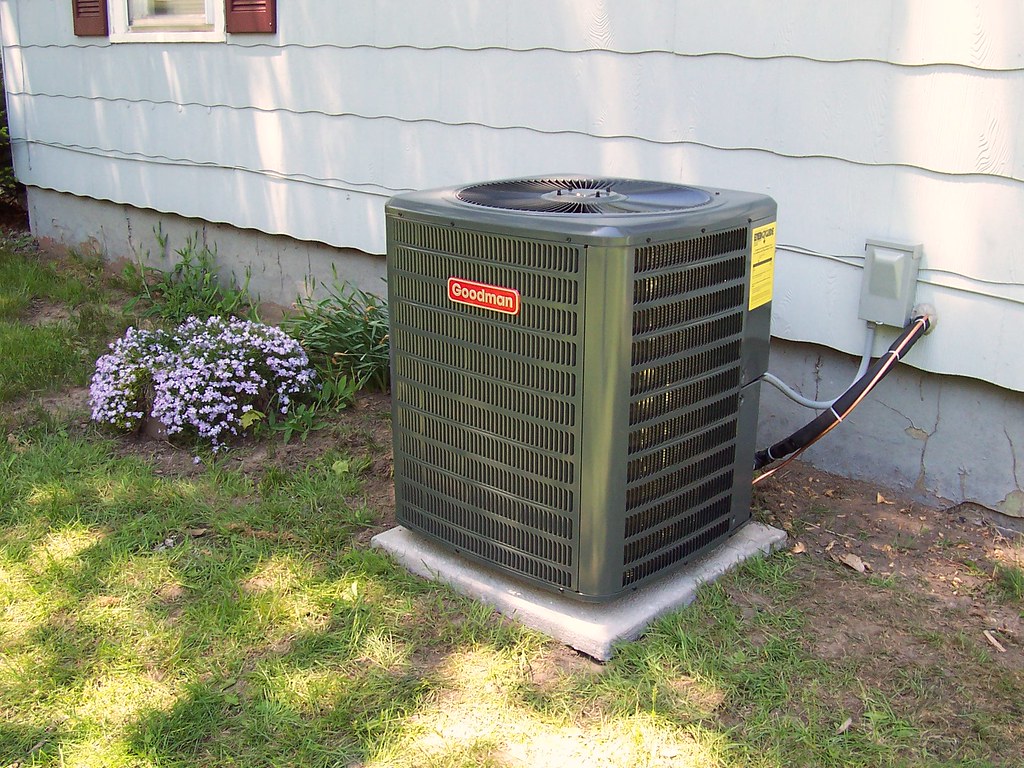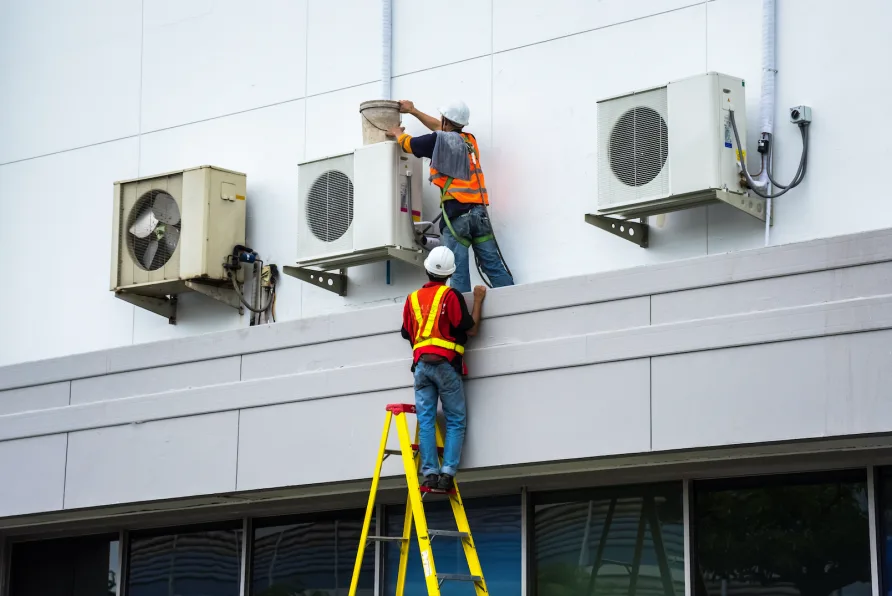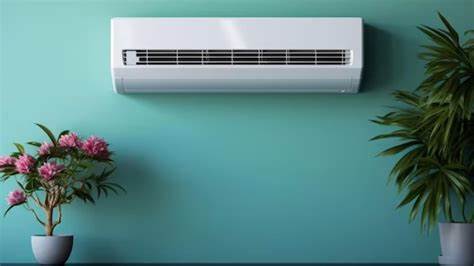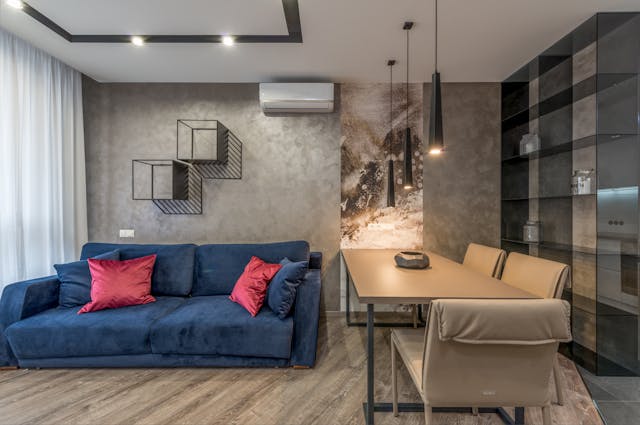Outdoor AC units, often overshadowed by the more visible indoor components of air conditioning systems, hold a unique position in ensuring our environments stay cool and comfortable. They embody the powerhouse of cooling operations, distinguishing themselves with their critical role in heat exchange and refrigerant circulation. This distinct functionality positions outdoor AC units as a fundamental aspect of air conditioning systems, offering a cooling solution that is indispensable in both residential and commercial settings.
Key types of outdoor AC units include the split system units for homes and the larger, more robust packaged units designed for commercial spaces. Each type is celebrated for its specific capabilities, from the split system’s adaptability to different living spaces to the packaged unit’s comprehensive approach suited for larger areas. Delving deeper, each outdoor AC unit type showcases unique features, operational methods, efficiency levels, and maintenance requirements.
The following sections will explore these elements in depth, providing a comprehensive insight into why outdoor AC units are pivotal in achieving effective and efficient cooling solutions. Through this exploration, we’ll gain a deeper appreciation for the outdoor AC unit’s role in our daily comfort and the broader air conditioning ecosystem.
What is an outdoor unit AC?
An outdoor unit AC is a critical component of any air conditioning system, usually placed outside the home or commercial premises. It encases vital elements such as the compressor, condenser coil, and fan, which collectively function to remove heat from the indoor environment and release it outdoors. This unit works in tandem with the indoor unit, facilitating a heat exchange process via a circulating refrigerant, thus efficiently cooling the indoor space.
Outdoor units are engineered to endure the rigors of external conditions and are available in different models, including split system units for residential settings and packaged units for larger, commercial applications. Their operational efficiency is indispensable for the air conditioning system’s overall performance, underscoring the necessity of regular upkeep to maintain their functionality and extend their service life.
Why is the outdoor unit crucial for AC systems?

The outdoor unit is essential for air conditioning systems because it serves as the core for heat expulsion. It houses critical components such as the compressor, condenser coil, and fan—all of which are vital for the cooling process. These components collaborate to absorb heat from the indoor air and efficiently release it outdoors.
Without the outdoor unit, the AC system would lack the ability to transfer heat outside, rendering it ineffective in cooling indoor spaces. This unit’s role is crucial across both residential and commercial settings, underscoring its significance in maintaining comfortable indoor environments.
It contains essential components for cooling
The outdoor unit houses key components such as the compressor, condenser coil, and fan. These elements are critical for the cooling process, working in concert to absorb heat from the indoor air, making it a fundamental part of the air conditioning system.
Also Read: Best Air Purifiers
It releases absorbed heat from indoors to outdoors
A primary function of the outdoor unit is to expel the absorbed heat from the indoor environment into the outdoors. This process is crucial for maintaining a comfortable indoor climate, ensuring that heat is continuously removed, thereby keeping indoor spaces cool and comfortable.
How does an outdoor unit AC function?
The outdoor unit AC operates through a synchronized effort with the indoor unit, facilitating heat exchange within the air conditioning system. It utilizes a refrigerant, a key substance adept at absorbing and transferring heat, to navigate between the indoor and outdoor environments. As the indoor air gets cooled, the refrigerant captures this heat and conveys it to the outdoor unit.
Within the outdoor unit, the compressor elevates the refrigerant’s temperature, enabling the condenser coil to release the absorbed heat into the outdoor air, while the fan assists in efficiently dispersing this heat away from the unit. This continuous cycle is essential for maintaining a cool and comfortable indoor atmosphere.
Collaborates with the indoor unit for heat exchange
The outdoor unit works in tandem with the indoor unit, establishing an efficient heat exchange system. This collaboration is essential, allowing for the transfer of indoor heat to the outside, which is vital for maintaining a comfortably cool indoor climate.
Circulates refrigerant to absorb and expel heat
It circulates a specialized refrigerant, engineered specifically for heat absorption and release. This refrigerant moves seamlessly between the indoor and outdoor units, absorbing heat from the indoor air and then expelling it outdoors, a critical function in the air conditioning process.
Types of outdoor unit AC systems
Outdoor unit AC systems are designed to cater to diverse environments, falling into two main categories: split system units and packaged units. Split system units are favored for residential use, characterized by their separation of outdoor and indoor components, which allows for versatile installation options and efficient cooling. Packaged units, in contrast, are tailored for commercial settings, incorporating all essential components into a single outdoor unit.
This design is particularly suited for large spaces that demand powerful cooling capabilities. Each system type is engineered with a specific use in mind, ensuring effective temperature management and comfort across both homes and commercial establishments.
Split system units for residential use
Split system units stand out for their adaptability in residential environments, characterized by their dual-component structure—an outdoor unit and an indoor unit. This design offers versatile AC installation options, making it possible to tailor cooling solutions to the specific needs and layouts of homes. Renowned for their energy efficiency, split systems enable precise temperature control in individual rooms or zones, enhancing comfort and reducing energy consumption.
Packaged units for commercial spaces
Packaged units are the go-to choice for commercial settings, integrating all essential cooling elements into a single outdoor unit. This streamlined approach facilitates easier installation and upkeep, ideally suited for managing the climate of large-scale spaces such as commercial buildings, retail centers, and factories. With their powerful performance, packaged units ensure consistent and effective temperature regulation across expansive areas, optimizing comfort and operational efficiency.
Maintaining an outdoor unit AC

Maintaining an outdoor unit AC is crucial for ensuring its longevity and optimal performance. Regular maintenance tasks include cleaning debris and leaves from around the unit to prevent blockages that can impair efficiency. It’s equally important to check and straighten the fins on the condenser coil; bent fins can restrict airflow, reducing the system’s ability to expel heat effectively.
Moreover, scheduling professional maintenance annually offers a comprehensive system check-up, identifying and resolving potential issues before they become major problems. These proactive steps are essential in keeping the outdoor unit in top condition, guaranteeing efficient cooling and energy usage.
Clean debris and leaves from the unit regularly
Ensuring the area around the outdoor unit is free from debris and leaves is essential for maintaining airflow and heat exchange efficiency. Regular cleaning helps prevent blockages that can impair the unit’s performance, keeping it running smoothly and effectively.
Check and straighten fins for efficient airflow
Inspecting and straightening the fins on the condenser coil is crucial for maintaining efficient airflow. Bent fins can restrict air movement, hindering the unit’s ability to expel heat. Properly aligned fins ensure optimal airflow, enhancing the system’s cooling efficiency.
Also Read: Best Air Filter for Home
Schedule professional maintenance annually
Annual professional maintenance is key to the long-term health of your outdoor AC unit. A professional technician can perform a comprehensive check-up, identifying and addressing any issues before they escalate. This scheduled maintenance is vital for ensuring the unit operates at peak efficiency, extending its lifespan and maintaining consistent cooling performance.
Common issues with outdoor unit ACs

Outdoor unit ACs may face a range of common issues, impacting their performance and efficiency. A prevalent concern is the condenser coil becoming clogged with dirt, which can drastically hinder the unit’s ability to release heat, leading to reduced cooling efficiency. Refrigerant leaks represent another significant problem, affecting the system’s cooling capacity and potentially raising operational costs.
Additionally, fan motor failures can cause overheating and damage to the unit if not addressed promptly. Recognizing and resolving these issues swiftly is essential for maintaining the outdoor unit’s optimal functionality and ensuring sustained cooling performance.
Condenser coil becomes clogged with dirt
A clogged condenser coil can severely reduce the outdoor unit’s heat expulsion capability, leading to diminished cooling efficiency. Accumulated dirt and debris act as insulators, preventing the coil from releasing heat effectively. Regular cleaning is essential to maintain system performance and prevent increased energy usage.
Refrigerant leaks affecting cooling efficiency
Refrigerant leaks pose a significant threat to the cooling efficiency of the system. Such leaks decrease the amount of refrigerant available for heat absorption and release, forcing the unit to work harder and consume more energy. Detecting and repairing leaks promptly can save energy and protect the system from further damage.
Fan motor failures leading to overheating
Fan motor failures can cause the outdoor unit to overheat, as the fan is critical for dispersing heat from the condenser coil. Without a functioning fan, the system’s ability to cool effectively is compromised, leading to potential overheating and system damage. Immediate attention to fan issues is crucial to avoid costly breakdowns.
Selecting the right outdoor unit AC
Choosing the right outdoor unit AC involves careful consideration of key factors to ensure optimal cooling performance and energy efficiency. First, it’s essential to assess the cooling area in square feet to match the unit’s capacity with the space’s needs. Next, units with high SEER ratings are preferable for their superior energy efficiency, promising significant energy savings.
Additionally, considering noise levels is crucial for units installed near living or work areas to ensure a comfortable and quiet environment. By meticulously evaluating these considerations, one can select an outdoor AC unit that perfectly aligns with their cooling requirements and environmental preferences.
Assess the cooling area in square feet
Evaluating the size of the area you need to cool is crucial. It’s important to choose an outdoor unit with a capacity that matches the square footage of your space. This ensures the system can cool efficiently without overworking, leading to better performance and longevity.
Look for units with high SEER ratings for energy efficiency
Focusing on outdoor units with high SEER (Seasonal Energy Efficiency Ratio) ratings can lead to significant energy savings. Higher SEER ratings mean the unit operates more efficiently, cooling the same space at a lower energy cost and contributing to environmental sustainability.
Consider noise levels for units close to living spaces
Noise levels are a critical consideration for units installed near living or work areas. Selecting an outdoor unit designed for quiet operation ensures your environment remains comfortable, without the intrusion of disruptive operational noise.
Split/Multi-Split Type Air Conditioners

Split and multi-split type air conditioners stand out for their flexibility and efficiency. These systems support individual room control, allowing you to adjust the temperature in specific areas independently. This capability not only enhances comfort but also offers energy savings, as you cool only the spaces in use.
Additionally, their design typically ensures quiet operation, making them ideal for both residential and commercial environments where noise sensitivity is a concern.
Individual Control
Individual control in split and multi-split type air conditioners empowers users to customize temperature settings in specific rooms or zones independently. This capability enhances personal comfort by allowing occupants to tailor cooling levels to their individual preferences, without impacting the efficiency of the entire system. It also promotes energy savings by enabling the selective cooling of only those areas that are occupied.
This targeted approach to climate control not only ensures optimal comfort but also aligns with economic and environmental goals, making it an ideal feature for both residential and commercial settings.
Energy and Cost Savings
Energy and cost savings are paramount advantages of implementing individual control in split and multi-split type air conditioners. This functionality permits the cooling of only occupied areas, dramatically reducing energy waste. The precision in temperature adjustment across different zones leads to a more efficient operation of the cooling system, translating into lower electricity bills and a minimized carbon footprint.
This strategic approach enhances energy utilization, offering substantial financial savings and promoting environmental sustainability, making it an appealing option for eco-conscious homeowners and cost-effective businesses.
Temperature Control by Inverter/Non-Inverter Compressors (Cooling)

Temperature control within air conditioning systems is greatly influenced by the choice between inverter and non-inverter compressors. Inverter compressors excel in adjusting their operating speed to seamlessly maintain the desired temperature, which enhances energy efficiency and ensures a stable cooling environment. Conversely, non-inverter compressors work at a constant speed, cycling on and off to keep the temperature within the set range, potentially leading to minor temperature fluctuations and increased energy consumption.
This distinction highlights the importance of selecting the appropriate compressor type, as it directly impacts the system’s energy consumption and the overall comfort level provided.
Humidifying / Dehumidifying
Advanced air conditioning systems are equipped with humidifying and dehumidifying functions, crucial for optimizing indoor air quality and comfort. These features adeptly manage indoor humidity levels, preventing air from becoming too dry or excessively moist, which is essential for a comfortable and healthful environment.
Heat Pump Performance
Heat pump technology enhances air conditioners by efficiently regulating temperature through heat transfer. This innovative approach allows for cooling in the summer and heating in the winter, providing a versatile climate control solution that is both effective and energy-efficient throughout the year.
Quiet Operation
The quiet operation of modern air conditioning systems is a significant advancement, particularly valued in residential areas and settings where noise is a concern. Through sophisticated design and technology, these systems operate discreetly, ensuring cooling processes do not disrupt the tranquility of indoor spaces.
You can also read about Wi-Fi air Conditioners for more cutting-edge cooling devices that can enhance your home’s efficiency and comfort.
Can You Have Central Air Without An Outside Unit?
The question of whether you can have central air conditioning without an outside unit introduces the innovative concepts of condenserless and water-cooled systems. These alternatives eliminate the need for a conventional outdoor unit, catering to scenarios where external installation is either impractical or not preferred, thus opening up new possibilities for cooling solutions in various settings.
Why central air conditioning requires an outdoor unit
Central air conditioning systems inherently require an outdoor unit because it houses the compressor and condenser coil, essential for the heat expulsion process. This component is vital in releasing the heat absorbed from the indoor air into the outside environment, a critical step in efficiently cooling the indoor space. The outdoor unit’s role in dispersing heat is what enables the indoor area to stay cool and comfortable.
Without this outdoor unit, the heat captured from the indoor environment would not be effectively removed, rendering the air conditioning process inefficient. Thus, the outdoor unit is indispensable for the functionality and efficiency of the best central air conditioning systems.
What are condenserless air conditioners?
Condenserless air conditioners are a specialized type of cooling system that operates without a conventional outdoor unit. Instead of expelling heat through an outdoor air-cooled condenser, these systems connect to a water source or cooling tower, using water as the medium to dissipate heat. This innovative approach allows for efficient cooling in scenarios where installing an outdoor unit is impractical or undesirable.
Condenserless air conditioners are particularly advantageous for buildings with limited outdoor space or for those aiming to preserve a specific architectural aesthetic without the intrusion of outdoor AC components. By employing alternative heat expulsion methods, condenserless systems provide a flexible and effective cooling solution, catering to unique architectural and environmental needs.
Pros
Condenserless air conditioners boast several key advantages, such as space efficiency, eliminating the requirement for large outdoor units. This feature is especially valuable in dense urban settings or for buildings with restricted exterior space. They also offer architectural flexibility, preserving the aesthetic integrity of buildings without the visual intrusion of external units.
Moreover, these systems typically result in lower noise levels within indoor environments, as the major noise-producing components are not situated in or near the living or workspace.
Cons
On the downside, condenserless air conditioners can present challenges, including higher initial installation costs due to the necessity of integrating with a water source or cooling tower. They demand consistent maintenance to ensure the water-based heat removal mechanism operates efficiently and remains clear of obstructions. Additionally, operational costs may increase, particularly in regions where water is a costly or scarce resource, given their reliance on water for dissipating heat.
How to Choose the AC without an outside unit?

Choosing an air conditioner without an outside unit requires careful consideration of several critical factors to ensure optimal performance and satisfaction. Energy efficiency stands at the forefront; prioritize systems with high efficiency ratings to minimize operational costs and lessen environmental impact. The cooling capacity of the unit is essential, as it must be capable of adequately cooling the designated area without being overtaxed.
Price considerations are also key, weighing the initial investment against potential long-term savings and operational efficiency. Furthermore, understanding the installation requirements and maintenance needs specific to condenserless air conditioning systems is crucial, as these can influence the overall practicality and cost-effectiveness of your choice. By thoroughly evaluating these factors, you can select an air conditioning solution that delivers efficient and effective cooling, tailored to spaces where an external unit is not an option.
1. The energy efficiency
Energy efficiency is paramount when choosing an AC without an outside unit. Look for models with superior energy ratings to ensure minimal electricity usage and a lower environmental footprint. High-efficiency systems not only contribute to cost savings on utility bills but also align with eco-friendly practices.
2. The capability of providing cool air
Assessing the cooling capacity is essential for selecting a unit that can effectively cool your designated space. It’s important to consider the square footage of the area and opt for a system that offers reliable and consistent cooling performance, ensuring your environment remains comfortable even in peak heat.
3. The price
Price considerations include both the upfront cost of purchasing the AC unit and the ongoing operational expenses. While models with higher energy efficiency may carry a higher initial price tag, they typically lead to significant energy bill reductions in the long run. Balancing your budget with the unit’s efficiency and cooling capabilities will help you find the best overall value.
Find Your Perfect Cooling Solution
Often overshadowed by their indoor counterparts, outdoor AC units are critical in keeping our environments cool and comfortable. These powerhouses handle the essential tasks of heat exchange and refrigerant circulation. However, traditional outdoor units might not always be the ideal solution. By carefully evaluating energy ratings, cooling capabilities, and long-term costs, you can find a system that perfectly suits your needs while maintaining optimal comfort.
Thinking a condenserless AC system might be a good fit for your home or business? Our expert HVAC technicians are here to guide you through the selection process and ensure you get the perfect cooling solution. Don’t let space constraints or aesthetic concerns keep you from enjoying a cool, comfortable environment.

